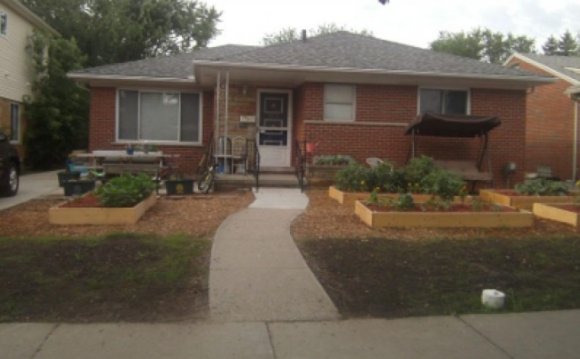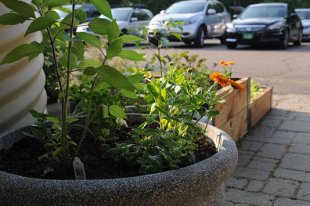

Use square-foot gardening techniques
to create a beautiful urban garden
When I started working at Gardener's Supply in the 1990s, my Vermont backyard was pretty green—with grass. Today, there's just a tiny bit of the original lawn left. Most of the available space has given way to trees, shrubs, perennials, annuals and stonework. Watch a slideshow of my garden in Burlington, VT.
In addition to my work at Gardener's Supply, I work in the gardening division at Church Hill Landscapes. In that role, I maintain dozens of gardens and learn a lot in the process. I believe that all gardening is good gardening.
Our front-yard garden is just outside the doors of our administration office in Burlington, VT.
IN front yards across America, most people grow and harvest the same crop: turfgrass. They water it constantly. They feed it regularly. And every week or two, they cut it and throw it away. All of this work for an inedible harvest! How about trading time on the mower for time tending crops you can actually eat?
 After all, there's not much that's "natural" about a front lawn. It's a monoculture that's rare in nature but standard in most neighborhoods. Upgrading your front yard to a vegetable garden is sure to raise a few eyebrows, but if you do it right, you'll impress the skeptics.
After all, there's not much that's "natural" about a front lawn. It's a monoculture that's rare in nature but standard in most neighborhoods. Upgrading your front yard to a vegetable garden is sure to raise a few eyebrows, but if you do it right, you'll impress the skeptics.
The goal is to keep it manageable, neat and productive. The truth is, vegetable gardens are not always pretty. Pests and blights can lead to less-than-perfect foliage and fruit. Nothing like a little blossom-end rot to ruin a ripening tomato. To keep the garden looking good, vegetables require a bit of effort and experimentation. You can be sure there will be failures, triumphs and surprises. And in the end, there will be food you can eat!
Will it Work in Your Yard?
 Sun. Most crops need a full day of sun to thrive, although some can get by with less. If your front yard gets less than eight hours of sun a day, consider shade-tolerant crops, such as salad greens. Another option: Put your planters on casters or platforms with wheels so you can follow the sun.
Sun. Most crops need a full day of sun to thrive, although some can get by with less. If your front yard gets less than eight hours of sun a day, consider shade-tolerant crops, such as salad greens. Another option: Put your planters on casters or platforms with wheels so you can follow the sun.
Water. Your garden will need it regularly, so have a plan in place for frequent watering. Consider setting up a soaker system to make it easy and efficient.
In-ground or raised beds? Although your site might allow in-ground planting, raised beds are a better choice because they reduce weeding chores and concentrate crops in easy-to-manage blocks. They also allow you to bring in fresh topsoil, a boon on sites where soil may be unhealthy due to road salt or other contaminants. Raised beds also frame your garden for a more manicured look that may stave off complaints from lawn-loving neighbors.
Time. It's fine to dream big, but be realistic about how much time you have to spend in the garden — and how much your family members will help out. Start with a scalable plan, so you can expand in the seasons to come.
Regulations. Some communities and homeowners' associations restrict the amount of non-lawn space they allow in front yards. Before you dig, make sure that there are no regulations in your area that prevent you from having a front-yard vegetable garden. Fortunately, the tide is changing to allow for more creative use of front yards. For more information, read the blog post, Saved! A Front Yard Vegetable Garden in Quebec.
Making a Plan
Once you've decided how much you can take on, sketch a plan on graph paper, or use our free online Kitchen Garden Planner, which uses square-foot gardening techniques to create gardens. Make raised beds that no more than 4 feet wide, so they're easy to access from the sides. Many crops will thrive in containers, so consider using those, too.















